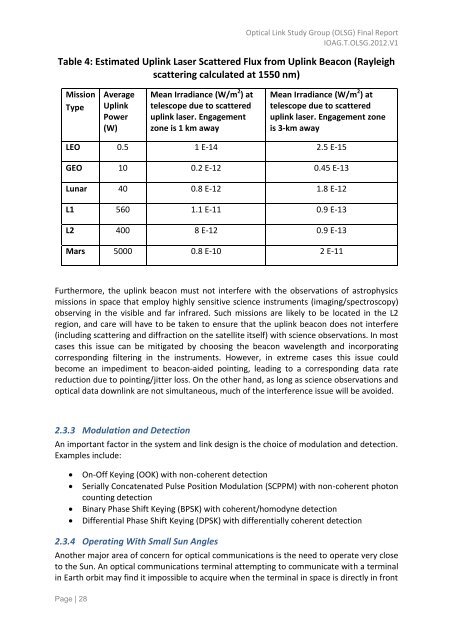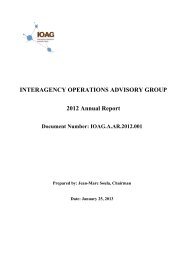OLSG Report_Final_06_05_12 - Interagency Operations Advisory ...
OLSG Report_Final_06_05_12 - Interagency Operations Advisory ...
OLSG Report_Final_06_05_12 - Interagency Operations Advisory ...
Create successful ePaper yourself
Turn your PDF publications into a flip-book with our unique Google optimized e-Paper software.
Optical Link Study Group (<strong>OLSG</strong>) <strong>Final</strong> <strong>Report</strong><br />
IOAG.T.<strong>OLSG</strong>.20<strong>12</strong>.V1<br />
Table 4: Estimated Uplink Laser Scattered Flux from Uplink Beacon (Rayleigh<br />
scattering calculated at 1550 nm)<br />
Mission<br />
Type<br />
Average<br />
Uplink<br />
Power<br />
(W)<br />
Mean Irradiance (W/m 2 ) at<br />
telescope due to scattered<br />
uplink laser. Engagement<br />
zone is 1 km away<br />
Mean Irradiance (W/m 2 ) at<br />
telescope due to scattered<br />
uplink laser. Engagement zone<br />
is 3-km away<br />
LEO 0.5 1 E-14 2.5 E-15<br />
GEO 10 0.2 E-<strong>12</strong> 0.45 E-13<br />
Lunar 40 0.8 E-<strong>12</strong> 1.8 E-<strong>12</strong><br />
L1 560 1.1 E-11 0.9 E-13<br />
L2 400 8 E-<strong>12</strong> 0.9 E-13<br />
Mars 5000 0.8 E-10 2 E-11<br />
Furthermore, the uplink beacon must not interfere with the observations of astrophysics<br />
missions in space that employ highly sensitive science instruments (imaging/spectroscopy)<br />
observing in the visible and far infrared. Such missions are likely to be located in the L2<br />
region, and care will have to be taken to ensure that the uplink beacon does not interfere<br />
(including scattering and diffraction on the satellite itself) with science observations. In most<br />
cases this issue can be mitigated by choosing the beacon wavelength and incorporating<br />
corresponding filtering in the instruments. However, in extreme cases this issue could<br />
become an impediment to beacon-aided pointing, leading to a corresponding data rate<br />
reduction due to pointing/jitter loss. On the other hand, as long as science observations and<br />
optical data downlink are not simultaneous, much of the interference issue will be avoided.<br />
2.3.3 Modulation and Detection<br />
An important factor in the system and link design is the choice of modulation and detection.<br />
Examples include:<br />
<br />
<br />
<br />
<br />
On-Off Keying (OOK) with non-coherent detection<br />
Serially Concatenated Pulse Position Modulation (SCPPM) with non-coherent photon<br />
counting detection<br />
Binary Phase Shift Keying (BPSK) with coherent/homodyne detection<br />
Differential Phase Shift Keying (DPSK) with differentially coherent detection<br />
2.3.4 Operating With Small Sun Angles<br />
Another major area of concern for optical communications is the need to operate very close<br />
to the Sun. An optical communications terminal attempting to communicate with a terminal<br />
in Earth orbit may find it impossible to acquire when the terminal in space is directly in front<br />
Page | 28



